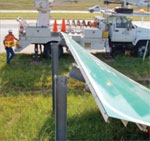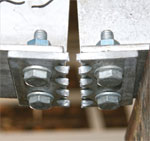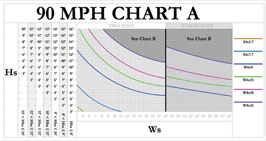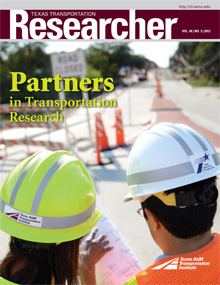Working together on a host of projects over the years, Texas A&M Transportation Institute (TTI) researchers at the Riverside Campus and Texas Department of Transportation (TxDOT) engineers have discovered innovative solutions involving the safety, installation and maintenance of the state’s seemingly endless number of highway signs. And, for the last four decades, the team has ensured that wet-weather travel on the state’s 80,000 miles of roadways is safe — thanks to a little-known but vital process of evaluating highly sophisticated and seldom-seen pieces of machinery built just for that purpose.
Skid Rigs and TTI’s Central/Western Field Test and Evaluation Center
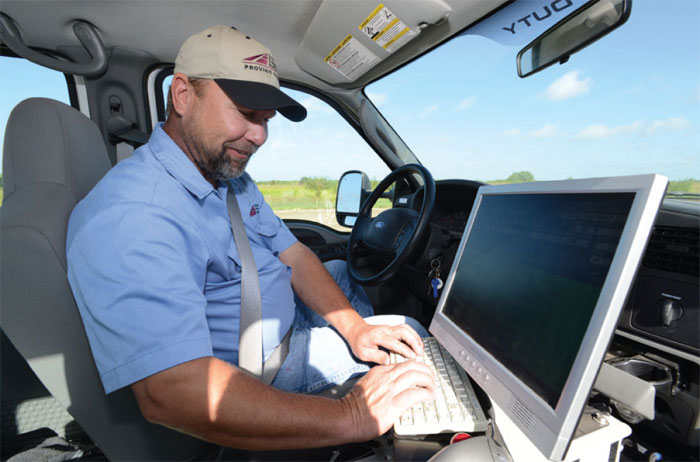
TxDOT owns seven friction measurement systems, commonly called skid rigs. At a price tag of $200,000 each, skid rigs consist of a heavy-duty pickup truck and trailer equipped with high-tech systems designed to measure the friction characteristics of pavement.
“Texas and every state in the country are constantly fighting friction loss: an invisible and extremely dangerous enemy,” TTI Senior Research Specialist Dick Zimmer explains. “Over time, pavements can deteriorate and become slick from wear, and when they’re wet, it’s a recipe for disaster. Pavement is funny. You can’t just look at it and tell it’s dangerous. You have to test it.”
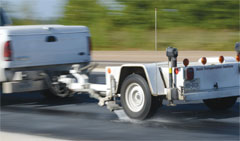
To test the pavements, TxDOT uses its skid rigs to drive over half of its entire road system each year, says Magdy Mikhail, TxDOT’s director of the Pavement and Materials Systems Branch. “If the testing shows that a pavement is losing friction, then we determine what maintenance is required — like a new seal coat for example.”
But how does TxDOT know that its skid rigs are working properly?
“In 1971, TTI opened the Field Test and Evaluation Center, located here at the Riverside Campus. In a nutshell, we test skid rigs, not only from Texas but from numerous other states as well,” explains Zimmer, who’s been evaluating these skid rigs at TTI for more than 40 years. He’s also served as the lead author on several related ASTM standards.
In 2011, the facility — now known as the Central/Western Field Test and Evaluation Center — was accredited by the American Association for Laboratory Accreditation for ISO 17025.* “We’ve conducted nearly 500 of these evaluations and calibrations over the years,” Zimmer says.
That evaluation is a 3- to 5-day process that includes tests for compliance to ASTM standards and comparison of the state’s skid rig to TTI’s reference skid rig. They are both driven 108 times on three different types of pavements at three different speeds. The measurements of the two friction systems are initially compared. The numerous components are checked, recalibrated and tested again on the track. If maintenance or repair is needed, that work is performed as well.
“The public just drives down the road, never thinking of the people, the equipment and the technology that go into testing just one characteristic of our highway system,” Zimmer says. “It boils down to this: roads get slippery, and slippery roads can be dangerous. That’s why knowledge and prompt maintenance can save lives.”
“As an agency, we are very fortunate to have a facility like the one at TTI,” Mikhail says. “I feel like we are partners in the effort to provide the best and safest roadways possible for Texans. TTI’s evaluation center is a valuable resource for us.”
Highway Signs and the TTI/TxDOT Relationship
Over the last several years, TxDOT has discovered it was having problems related to its roadway signs — ranging from the large 18-foot-wide green guide signs to the much smaller mile-marker signs that cover the state’s transportation landscape.
For example, in West Texas, high-wind events were blowing down large guide signs at a higher than normal rate. In other districts, the use of small signs on slipbase supports was found to affect their crashworthiness.
“There were numerous issues we wanted to explore,” says TxDOT Transportation Engineer Doug Skowronek. “We organized a panel and developed a list of the various improvements we felt were needed. Many of those items were identified by the maintenance crews across the state responsible for maintaining and installing the signs.”
The list continued to grow, and TTI was awarded a two-year project, headed up by TTI Research Engineer Roger Bligh.
“Many of the design practices that TxDOT uses for sign mounting were established years ago, and because sign materials and installation methods change, problems sometimes arise,” Bligh says. “To complicate the issue further, the types of vehicles on the road change over time, as do the operating conditions of our highways.”
Skowronek says that the benefits from that two-year project were so great that TxDOT decided to extend the research for another year so additional issues could be examined. The project, Development Guidance for Sign Design Standards, was recently completed, resulting in an exhaustive 350-page report that identifies problems, findings, conclusions and recommendations.
“I was stunned at the detail and thoroughness of the report,” Skowronek says. “When you look through the report, you realize the work that went into it. It was very well thought out and documented, leaving nothing unanswered.”
TxDOT is now in the process of implementing recommendations from the report and expects a safer roadway, more efficient use of time and resources, and a substantial cost savings.
Among the findings and recommendations of the research project are:
- Fuse plate failures were causing large guide signs to come down during high-wind events, so TTI developed new wind-load charts that properly account for the fuse plate strength.
- The use of expensive and cumbersome vertical supports for large guide signs, called stiffeners, are not needed to achieve proper impact performance of the sign support system.
- Researchers determined a minimum area for signs mounted on slipbase supports so that, upon impact, the slipbase works properly and minimizes damage to the impacting vehicle.
“Obviously, we rely on TTI when it comes to these devices along our roadways,” Skowronek says of the relationship between the two agencies. “TTI helped us create the standards we use to install and maintain these signs and roadside devices. We come up with a ‘what if’ scenario, and TTI comes up with the answers.”
* Not included in the original article: The TTI Proving Ground is an International Standards Organization (ISO) 17025 accredited laboratory with American Association for Laboratory Accreditation (A2LA) Mechanical Testing Certificate No. 2821.01.
